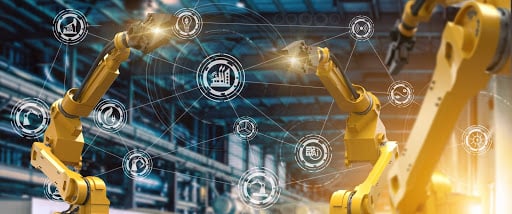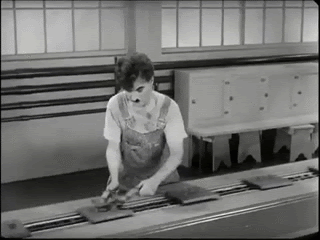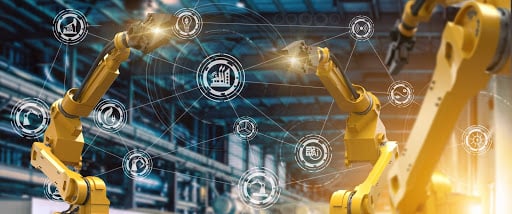Table of Contents
Why industrial automation is important
Advantages and Disadvantages of Industrial Automation
The Hierarchy of Industrial Automation
Types of Automation Tools
Industrial Automation Examples
Automation in 2020 and beyond

There was a time, not so long ago, when many of the products purchased by businesses and consumers were manufactured in large factories employing hundreds or even thousands of workers. Such factories were more productive and profitable than earlier manufacturing methods because of mechanization—the enhancement (not replacement) of human labor through powered machines and tools that increased each worker’s productivity.
Mechanization was the primary contribution of Henry Ford’s innovations in assembly-line technology—production-line innovations that enabled Ford to build tens of thousands of automobiles every year, and sell them at prices his factory workers could afford.
Although mechanization increased productivity, humans were, by and large, still in the loop. And humans, sadly, possess a number of counterproductive characteristics:
- They commit human errors.
- They don’t do things the same way every time.
- They get sick.
- They are easily distracted.
- They get bored with mind-numbing repetitive tasks.
- They have feelings and emotions that hamper their ability to perform at a high level.
- They insist on engaging in non-value-added activities, such as meetings.
- They demand things such as higher wages, benefits, and paid time off.
Hence, factory owners sought a level above mechanization to further boost productivity and profits. That next level is automation.
What is Industrial Automation?
With automation, human labor is replaced by machines. So, instead of a human madly tightening bolts (like Charlie Chaplin’s character in the 1936 film Modern Times) with a manual wrench or a power tool, a machine automatically tightens the bolts instead, with no human intervention.
 https://i.pinimg.com/originals/1b/6b/77/1b6b77b2f18c8a78f9204c84e9849774.gif
https://i.pinimg.com/originals/1b/6b/77/1b6b77b2f18c8a78f9204c84e9849774.gif
The term “industrial automation” is thus defined as the application of machines (and in particular, machines controlled by computers) to take the place of human labor.
Why Industrial Automation is Important
In the modern, global economy, it’s more important than ever for manufacturers, especially those in developed countries such as the United States, to invest in industrial automation. The competition, in both quality and cost, from manufacturers in developing nations is simply too robust to be ignored. In order to remain profitable, established manufacturers must squeeze out as much waste as possible from their processes, to make them lean and efficient with consistent high-quality output.
For most industrial processes, this means turning to automation.
Advantages and Disadvantages of Industrial Automation
When properly implemented, industrial automation affords a number of advantages:
- Increased productivity: Automated processes can be executed faster
- Decreased operational costs: Automation can result in reduced costs for labor and quality assurance of the cost of goods sold can decrease dramatically
- Product quality: Automated processes can consistently produce high-quality output
- Decreased routine process parameter checks: Because automated processes can monitor and adjust their own process parameters, there is less need for humans to perform these tasks
- Safety: Industrial robots can handle jobs that are dangerous for humans, thereby increasing workplace safety
- Flexibility: Automated production machinery is easily reconfigured for different products, product lines, and production run sizes
- Simulation modeling: Industrial automation enables a new process to be simulated in a virtual environment, using tools such as finite element analysis (FEA) and computational fluid dynamics (CFD), to identify issues and make adjustments before going into production
However, there are some disadvantages as well, the most prominent being the high initial costs of procuring, configuring, and deploying industrial automation hardware and software. Personnel must also be trained on how to use the equipment most effectively and maintain it for maximum uptime.
Some of these costs can be offset by taking a strategic approach to automation, by automating a few easy, high-margin processes first and realizing cost savings that can be applied to gradual implementation across the enterprise.
Equally important, however, is the fact that automation requires companies to first closely examine their processes and eliminate sources of waste. You gain nothing by automating a process you shouldn’t be doing in the first place.
The Hierarchy of Industrial Automation
Not all industrial automation control systems are created equal; a hierarchy of systems that can be applied in a manufacturing environment. From the lowest level to the highest, they are:
- Field-level: Simple, “dumb” devices such as temperature and pressure sensors, motors, actuators, and barcode readers
- Control-level: Devices that process sensor input and send command signals to actuators such as motors, valves, and relays; often “hard-wired” for a specific task
- Programmable logic controllers: Microprocessor-driven devices that are similar to control-level devices except that they can be reprogrammed for different tasks
- Supervising and production control-level: Systems that monitor the lower-level devices and enable humans to initiate production runs, set production targets, and perform other supervisory tasks
- Information or enterprise level: Systems related to production planning, forecasting, sales-order processing, and other overall business activities
Types of Automation Tools
The reduced cost increased computational power of modern computer hardware has enabled the development of a wide range of automation tools, such as:
Supervisory control and data acquisition (SCADA): This tool falls in the supervising and production control category, combining data from lower-level devices and displaying it on easy-to-read dashboards. This tool summarizes the health of one or more manufacturing processes and enables real-time monitoring and control.
Human-machine interfaces (HMIs): Gone are the are the dials, knobs, sight glasses, and gauges of yesteryear; industrial automation devices can now be controlled on PCs, laptops, tablets, and even mobile phones and augmented-reality (AR) headsets.
Artificial neural networks (ANNs): This is a class of artificial intelligence (AI) that is used in machine learning systems. These technologies “learn” by examining thousands of data objects, such as digital images, that are annotated in some way, and forming a mathematical model and adjusting it over time so that the system can label or classify a given data object in a way that matches its annotations.
In an industrial context, a computer vision system can learn to distinguish manufactured items that meet quality criteria from those that do not. Such an automated system could examine every single item, not just a sampling as is typically done by human quality inspectors. By incorporating sensor data, an AI-powered QA system could identify faulty items much more accurately than could a human inspector.
Distributed control systems (DCSs): In this system, process controllers are distributed as closely as possible to the production equipment, rather than centralizing control in one high-level device. This approach increases reliability while still enabling supervisory visibility through HMIs.
Robotics: Industrial robots are becoming increasingly capable and adaptable. Fixed factory-floor robots are easier than ever to program and can be adapted to different products and product lines. Although they have not yet reached the level of understanding natural-language instructions (a la R2-D2), their user interfaces are more intuitive and require less skill to operate than the industrial robots of old.
Industrial Automation Examples
Many industries have embraced automated processes and are reaping the benefits. Here are just a few examples:
Automobile manufacturers have been deploying industrial robots for decades; now, most assembly lines employ robots for both parts fabrication and assembly of the final product. Despite some missteps, such as Tesla’s recent troubles with over-automated processes, the future of automobile manufacturing will continue to see increased levels of automation.
Additive manufacturing, also known as 3D printing, is a technology seeing wide adoption in aerospace, among other industries. 3D printing enables precise control of the shape and size of each manufactured part and enables the use of advanced lightweight, high-strength, high-durability materials required in airplanes, helicopters, and spacecraft.
The biopharmaceutical industry is turning to industrial automation of biological processes. These processes require precise monitoring and control of the bioreactor environment to ensure high yield and the all-important quality, efficacy, and safety of the end products. Companies such as Hamilton are developing in-line sensors for various chemical and physical parameters that offer high precision over a wide range of operating conditions.
Further, manufacturers in many industries are turning to computer-aided manufacturing (CAM) to drive manufacturing automation. Through a process called “3D Interoperability,” design files developed in computer-aided design (CAD) software can be imported directly into the manufacturing machinery, reducing the errors and ambiguities that result from manually translating engineering drawings into manufacturing parameters. Further, CAM application developers are looking for ways to automate the pre-processing step where the CAD file is prepared for a specific manufacturing step. Spatial SDKs are at the forefront of enabling these developers.
Automation in 2020 and Beyond
The 2020s may well be the decade that sees the steady trickle of automation development turn into a firehose of rapid innovation. Driven by advances in artificial intelligence, wireless sensor networks, and robots and other automated machinery, the manufacturing floor of tomorrow will look quite different than it does today. Gone will be the army of human operators performing dirty, dangerous, repetitive tasks day in and day out; with fully automated processes in place, they will be free to focus their talents and knowledge on further improving productivity, quality, and innovation.
The result could be a renaissance in manufacturing in both industrialized and developing countries, bringing high-quality and low-cost manufactured goods to businesses and consumers around the world.




















